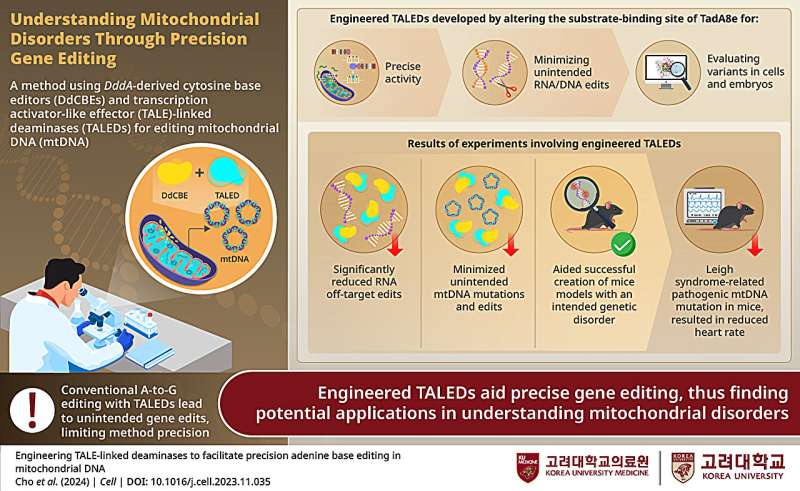This article has been reviewed according to Science X's editorial process and policies. Editors have highlighted the following attributes while ensuring the content's credibility:
fact-checked
proofread
Study explores a novel and precise mitochondrial gene editing method

Gene editing technology could revolutionize the treatment of genetic diseases, including those that affect the mitochondria—cell structures that generate the energy required for the proper functioning of living cells in all individuals. Abnormalities in the mitochondrial DNA (mtDNA) could lead to mitochondrial genetic diseases.
Targeted base editing of mammalian mtDNA is a powerful technology for modeling mitochondrial genetic diseases and developing potential therapies. Programmable deaminases, which consist of a custom DNA-binding protein and a nucleobase deaminase, enable precise mtDNA editing.
There are two types of programmable deaminases for genome editing: cytosine base editors and adenine base editors, such as DddA-derived cytosine base editors (DdCBEs) and transcription activator-like effector (TALE)-linked deaminases (TALEDs).
These editors bind to specific DNA sites in the mitochondrial genome and convert bases, resulting in targeted cytosine-to-thymine (C-to-T) or adenine-to-guanine (A-to-G) conversions during DNA replication or repair. However, the current gene editing approaches have many limitations, including thousands of off-target A-to-G edits while using TALEDs.
Accordingly, researchers from Korea University engineered TALEDs for improved A-to-G precision editing. Notably, in this breakthrough study conducted by Associate Professor Hyunji Lee and his collaborators, researchers succeeded in developing the world's first animal model with A-to-G mtDNA edits achieved using engineered TALEDs. Their study was published in Cell.
To overcome the limitation of unintended RNA edits, the researchers modified the substrate-binding site in TadA8e—the deoxy-adenine deaminase region in TALEDs—and developed TALED variants with fine-tuned deaminase activity.
Assoc. Prof. Lee says, "To address limitations of the conventionally used TALEDs, we created and assessed 209 TALED variants. Each variant replaced one of the 11 amino acid residues near the substrate-binding pocket in the protein of interest with one of the other 19 amino acid residues."
The results of the study showed that the engineered TALEDs significantly decreased off-target RNA edits by over 99%. The engineered TALEDs also minimized off-target mutations in mtDNA and bystander edits—unintended changes that occur at locations in the genome near the targeted site during editing processes—at a specific target site. In contrast to the original TALEDs, these engineered TALEDs did not exhibit toxicity. They also did not lead to developmental arrest in mouse embryos.
Consequently, the researchers generated mice carrying pathogenic mtDNA mutations associated with Leigh syndrome—a mitochondrial genetic disease. The generated mice displayed reduced heart rates, which is an expected disease outcome.
The ability to edit mtDNA with improved precision opens avenues for studying and treating other mitochondrial genetic disorders. The research aligns with the broader trend of personalized medicine, offering hope for individuals with specific mitochondrial genetic variations.
As the first gene editing technology-based treatment received FDA approval in 2023, Prof. Lee's research hints at a potential future in which the mitochondrial gene editing technology gains similar recognition. With mitochondrial genetic diseases affecting approximately one in 5,000 people globally, this technology could bring transformative treatments in the next five to ten years.
The achievement of correcting mitochondrial A-to-G in mice not only highlights the efficacy of the novel gene editing method but also signals a significant step toward developing approved treatments for mitochondrial genetic diseases. The impact of this research extends beyond the laboratory, holding promise for real-world applications that could revolutionize health care and improve the lives of those affected by mitochondrial disorders.
"The final goal of my research is to treat diseases caused by mutations in mtDNA and help thousands of people affected by such diseases," concludes Assoc. Prof. Lee. Indeed, this research could revolutionize the way genetic disorders are clinically treated while also contributing to the development of safer and more reliable methods for genetic manipulation.
More information: Sung-Ik Cho et al, Engineering TALE-linked deaminases to facilitate precision adenine base editing in mitochondrial DNA, Cell (2024). DOI: 10.1016/j.cell.2023.11.035
Provided by Korea University College of Medicine





















